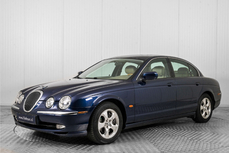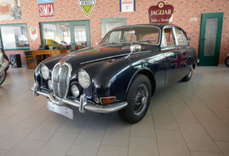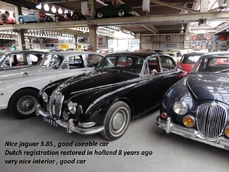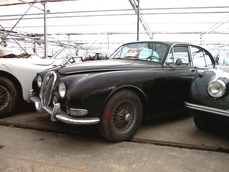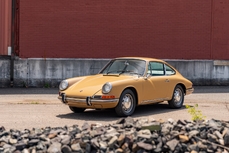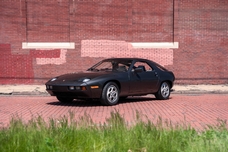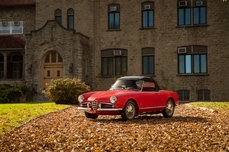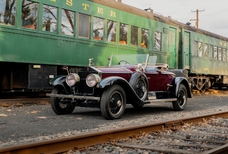Jaguar S-Type 1938
General description :
Between 1936 and 1939, a British manufacturer by the name of S. S. Cars Ltd. produced a 2-seat sports car they dubbed the SS Jaguar 100. In March 1945, the S. S. Cars shareholders agreed to change the name to Jaguar Cars Limited, giving birth to the Jaguar we know today.
The SS Jaguar 100 originally came with a 100 hp, 2.5 L straight-6 that could output a theoretical max speed of 100 mph, hence the name. That engine was enlarged in 1938 to a 3.5 L which increased horsepower figures to 125 hp. Both versions had twin SU carburetors and a four-speed transmission. Only 314 cars were reportedly produced before production was interrupted by World War II.
This particular example, Chassis #1B1306DN , is an incredibly authentic recreation of an SS 100 built in 2007 by Suffolk Sportscars, Ltd. of England and titled as a 1964 Jaguar. It uses a 4.2 L Jaguar XK engine rebuilt specifically for this car with a lightened flywheel and fitted with twin 2” SU HSB carburetors & choke unit mated to a Jaguar Short Compact 4-speed manual transmission with overdrive. The body was finished in green over a Saddle tan Connolly leather interior with contrasting green Wilton carpets. The dimensions and finishes of the car are exact to the 1938 model it is based on, and even the Lucas headlights are manufactured by the same supplier.
The original owner lovingly enjoyed the car until 2013, during which he serviced it annually at a Jaguar specialist shop and always kept it in a garage. It was listed for sale by Suffolk Sportscars themselves and was purchased by its current owner in 2018, who imported it to Florida, where it remained until it was placed on consignment with us, showing just over 21,000 miles on the odometer.
We entrusted this Jaguar to Leading Edge Autosport in West Chester, PA, who gave it a well-deserved service. They changed the oil and its filter, replaced the spark plugs and properly set the gap, cleaned the cap and rotor, tightened the driver’s wiper blade, replaced the brake hoses, flushed the brake and clutch systems, fixed multiple fuel leaks in the engine bay, greased all zerk fittings, and replaced the oil return line.
As it sits, this Suffolk SS100 is a low-mileage, perfect replica of a car that, for most of us, will be completely unobtainable. Having such a replica allows you to enjoy it in ways that you wouldn’t be able to enjoy the real thing for fear of damaging such an irreplaceable work of art. The modern drivetrain and brakes underneath its vintage-looking skin will also provide a lot more motoring excitement and safety than the aging mechanics of a real 1938 Jaguar would have. It can thus be driven like a regular car with the benefit of looking like anything but one. Another benefit of using Jaguar running gear is that even though Suffolk Sports Cars is no longer producing these replicas; the car can still be serviced by any shop that knows how to work on vintage Jaguars, further extending its lifespan.
Document description :
1938 Jaguar S-Type is listed sold on ClassicDigest in Philadelphia by Adolfo Massari for $90000.
Car Facts
Car type : Car Make : Jaguar Model : S-Type Engine size : 3.5 Model Year : 1938 Sub type : Convertible Color : Green Condition : 4 Location : Philadelphia, PA Vehicle Registration : Normal
Sold
Seller Information
Sold
People who viewed this Jaguar S-Type also viewed similar Jaguar listed at ClassicDigest
Other cars listed for sale by this dealer
About Jaguar
Ah, the story of Jaguar, from its early days as the SS Cars Ltd. to its pinnacle with the D-type, and the street-going evolution in the form of the iconic E-type. There's something quintessentially British about this tale, and I'll narrate it as a British journalist might.In the Beginnings:
Our journey into the world of Jaguar begins in the 1930s, when a company known as SS Cars Ltd. emerged. Despite the unfortunate coincidence of their initials with the rising political tensions in Europe, they started producing stylish and performance-oriented cars. The SS 100, introduced in 1936, was a symbol of elegance and speed, setting the stage for what would become Jaguar.
The Birth of Jaguar:
As the shadows of World War II loomed, SS Cars Ltd. wisely decided to disassociate themselves from the SS initials. Thus, in 1945, they officially became Jaguar Cars Ltd., a name that would soon be synonymous with British luxury and performance.
The XK Series:
Jaguar's post-war era brought us the XK 120, a true sensation in 1948. With its sleek design and a powerful 3.4-liter inline-six engine, it became the world's fastest production car. The XK 120 was the blueprint for what lay ahead – Jaguars that blended style with speed in a uniquely British fashion.
The D-type Dominance:
Then came the D-type, a true racing legend. Introduced in 1954, it won Le Mans three times in the 1950s, showcasing Jaguar's engineering prowess. With its innovative monocoque construction and the iconic fin at the back, the D-type was the apex of Jaguar's motorsport success.
The E-type Emergence:
But the true turning point arrived in 1961 with the introduction of the E-type, often described by Enzo Ferrari as "the most beautiful car ever made." Its long bonnet, curvaceous body, and a 3.8-liter engine delivering exhilarating performance made it an instant classic. The E-type was not just a car; it was a work of art on wheels, and it could hit 150 mph on the road.
Street and Racing Success:
The E-type's beauty was matched by its capability on the track. The lightweight E-types were particularly successful in various racing events, cementing Jaguar's reputation as a force to be reckoned with in motorsport.
The Age of Refinement:
As we delve deeper into the Jaguar story, we find that the 1950s and 1960s were an age of refinement and expansion. Alongside the magnificent D-type and the E-type's iconic emergence, Jaguar introduced models that further solidified its reputation for luxury and performance.
The MK2:
In the late 1950s, Jaguar unveiled the MK2, a sports sedan that combined elegance with power. This sleek four-door saloon was a favorite of bank robbers and law enforcement alike, thanks to its exceptional speed and handling. The MK2 was a symbol of Jaguar's ability to blend sophistication with performance and had a successful racing career as well.
The XJ6:
Fast forward to 1968, and Jaguar launched a car that would define luxury saloons for decades to come – the XJ6. It was a masterpiece of engineering and design, featuring a smooth inline-six engine, independent rear suspension, and a spacious, beautifully appointed interior. The XJ6 was a symbol of British elegance and provided a ride so smooth that it seemed to glide over the road. It became the flagship model for Jaguar and set the standard for luxury saloons, showcasing a level of refinement that left competitors in awe.
The Blend of Classic and Modern:
While the MK2 and XJ6 represented the evolution of Jaguar's saloon cars, they maintained the brand's commitment to performance and luxury. These cars didn't just belong on the racetrack; they were equally at home cruising down the grand boulevards or gliding through the English countryside.
The Challenges of Change:
However, as the 1970s arrived, Jaguar, like many British automakers, faced financial challenges and changes in ownership. The British Leyland era brought both opportunities and struggles, as the brand navigated through various mergers and transitions.
Nevertheless, the legacy of the MK2 and XJ6, along with the D-type and E-type, continues to define Jaguar as a manufacturer that combines timeless elegance with a spirit of performance. These classic models, whether driven on winding roads or parked as collectors' treasures, serve as a testament to Jaguar's enduring presence in the world of automotive excellence.
The Jaguar story, from its early days as SS Cars Ltd. to the creation of automotive icons like the E-type, MK2, and XJ6, is a journey that reflects the very essence of British motoring – a blend of luxury, power, and style that continues to captivate enthusiasts and connoisseurs alike.




















